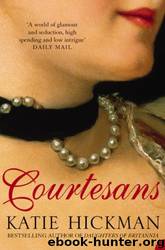Courtesans by Katie Hickman

Author:Katie Hickman [Hickman, Katie]
Language: eng
Format: epub
ISBN: 9780007401642
Publisher: HarperCollins Publishers
Published: 2003-08-14T23:00:00+00:00
* * *
* This is the date which is usually given. But in a letter to the novelist Bulwer Lytton written in 1831, Harriette remarked that she was born ‘ten minutes before eight o’clock, the 22nd February 1788’, and gave her age as forty-three. If this was the case, her seduction by the Earl of Craven would have taken place in 1804.
* Jane Austen was born in 1775 and died in 1817. Pride and Prejudice, written between October 1796 and August 1797, was published in 1813.
* Granville Leveson Gower became Earl Granville, British Ambassador to Paris, in 1824. See Daughters of Britannia.
* In her Confessions, Julia Johnstone claimed that Fred Lamb was, on the contrary, very generous to Harriette, and supported her to the tune of £100 a year, about £5000 today,
† The Marquis of Lorne, who was in his early thirties at the time of this exchange, became the Duke of Argyll in 1806. Harriette refers to him as both Lorne and Argyll in her Memoirs, using the spelling Argyle. For the sake of clarity I have called him Lorne throughout. The Duke later married his mistress, Caroline, the third of the beautiful daughters of the Earl of Jersey, after she was divorced by her husband, the Marquis of Anglesey, for her adultery.
‡ This was very probably an accommodation house.
* Although thought to have been a stocking-mender by profession, Harriette’s mother was the natural daughter of ‘a country gentleman’, a Mr Cheney. She had, Harriette claimed, struck Lady Frederick Campbell, aunt of the Duke of Argyll, so much with her beauty that she had been adopted by her, and brought up ‘as her own child’.
† ‘Demi-rep. A woman whose general reputation or, esp., chastity is in doubt. First recorded in Fielding’s Tom Jones (1749): “Vulgarly called a demi-rep; that is … a woman who intrigues with every man she likes, under the name and appearance of virtue … in short, whom everybody knows to be what nobody calls her.” Ex reputation.’ The Penguin Dictionary of Historical Slang.
* Harriette herself never mentions such a thing as the ‘Cyprians’ Ball’, although a contemporary drawing purports to show it.
* At the ‘Bal des Victimes’, given in Paris to commemorate parents and dose relatives murdered during the Terror, all the women wore their hair in this fashion. Many of them also wore a thin red ribbon around their necks – the mark of the guillotine – ‘a note of frivolity born of despair’. See Norman Hartnell’s Royal Courts of Fashion.
* According to Harriette, this was particularly so after the disgrace and eventual exile of her contemporary and friend Beau Brummell, who in her taste for simplicity she much resembles. ‘Do you know that Brummell is cut amongst us,’ the Duke of Leinster tells her of his Christchurch friends, ‘and who do you think sets the fashions there now?’ The answer was Harriette herself.
† Augustus Frederick Fitzgerald, 3rd Duke of Leinster (1791–1874), was Charles James Fox’s first cousin once removed. He was the grandson of Fox’s mother’s sister, Emily Leinster.
Download
This site does not store any files on its server. We only index and link to content provided by other sites. Please contact the content providers to delete copyright contents if any and email us, we'll remove relevant links or contents immediately.
Rewire Your Anxious Brain by Catherine M. Pittman(18586)
Talking to Strangers by Malcolm Gladwell(13286)
The Art of Thinking Clearly by Rolf Dobelli(10312)
Mindhunter: Inside the FBI's Elite Serial Crime Unit by John E. Douglas & Mark Olshaker(9260)
Becoming Supernatural by Dr. Joe Dispenza(8159)
Change Your Questions, Change Your Life by Marilee Adams(7678)
Nudge - Improving Decisions about Health, Wealth, and Happiness by Thaler Sunstein(7655)
The Road Less Traveled by M. Scott Peck(7553)
The Lost Art of Listening by Michael P. Nichols(7452)
Mastermind: How to Think Like Sherlock Holmes by Maria Konnikova(7276)
Enlightenment Now: The Case for Reason, Science, Humanism, and Progress by Steven Pinker(7271)
Win Bigly by Scott Adams(7133)
The Way of Zen by Alan W. Watts(6548)
Daring Greatly by Brene Brown(6472)
Big Magic: Creative Living Beyond Fear by Elizabeth Gilbert(5675)
Grit by Angela Duckworth(5553)
Ego Is the Enemy by Ryan Holiday(5344)
Men In Love by Nancy Friday(5192)
The Laws of Human Nature by Robert Greene(5073)
